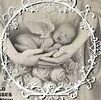When a loved one passes away, it can be difficult for families to decide what clothes to dress the deceased in. This is especially true if the person lost or gained weight in their final months or years of life, or if rigor mortis has made their regular clothing too tight to fit. In these cases, burial gowns can be a good option. They’re usually crafted from natural materials and look like robes or dressing gowns, and are designed with slits and drawstrings across the back to help adjust the fit as needed. Many funeral homes offer them as a convenience to customers.
There are also a number of artisans who make shrouds that can be used for green or natural burials, and they may be found through an online search. Some offer bespoke and custom work, often using heirloom and family textiles. Some of these garments are more specialized, such as those for infants who die at birth or shortly afterward. Beverly Duckett, an Oak Ridge resident who makes these garments for babies, describes her craft as a way to “be a helper in the midst of despair.”
Some families choose to dress their deceased in the clothing they normally wear. For older people, this could include a nightgown or pajamas. It might be less formal attire, such as a suit or jacket, for younger people. For infants, some charities and businesses make handmade baby funeral clothes, as well as smocks for premature and stillborn babies.
While the clothing selected will not decompose, it must be removed before the body is buried or cremated. This is because the clothing can interfere with the cooling process that takes place in a casket, or it can cause harm to the delicate body when being moved. It’s best to consult with the funeral home about what type of clothing is appropriate for a burial outfit.
The deceased’s religion can also play a role in how they are dressed for burial. In Islam, the body is washed before being covered with a white sheet. After that, men are clothed in a cotton or linen tachrichim and women in a head covering. Jewish people may be buried in a traditional outfit called a shroud, which includes a shirt, pants, coat and belt, or they can be buried with their regular daily attire.
The clothing chosen for a burial outfit should be clean and without stains. Some of it is likely to be covered with ashes after the service, so it should be washable. If a person’s body is to be buried in a natural or green cemetery, then the clothes must be biodegradable and free of plastic or metallic threads, buttons and zippers. These guidelines are usually imposed by the cemetery or burial grounds because of environmental concerns.
